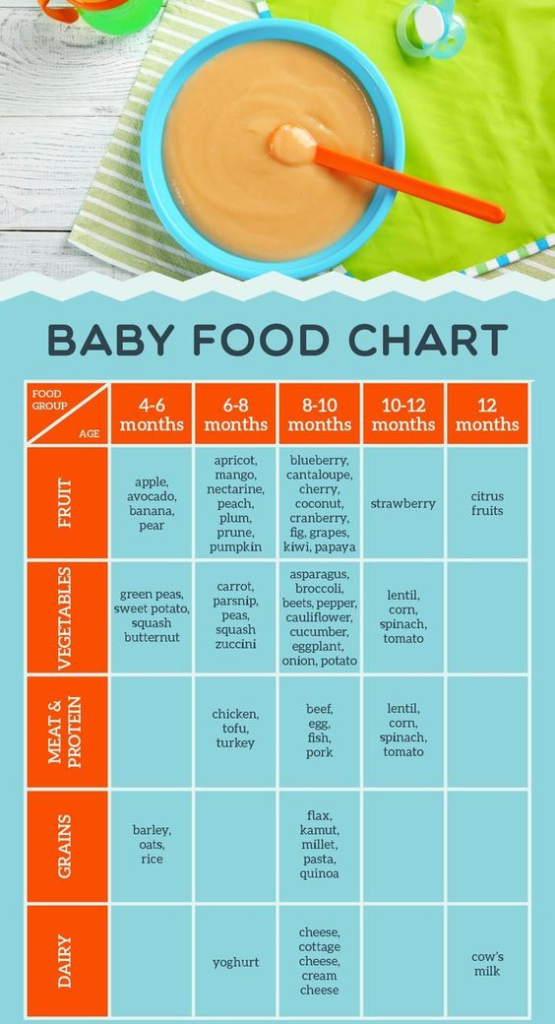Food Chart for Baby’s First Year: Feeding Guide

Embark on a delightful journey with our comprehensive baby feeding guide. From milk to solids, nurture your little one’s growth with a harmonious blend of nutrition and love.
Complete Guide to Feeding Your Baby: Nutritional Schedule & Food Chart for the First Year
Raising your baby during their first year involves discovering, exploring, and watching them grow. A vital aspect of this journey is developing a feeding schedule that aligns with your baby’s growth and nutritional needs. From the tender days of breastfeeding or bottle-feeding to the captivating entry into solid foods, each phase composes a crucial melody in sculpting your baby’s relationship with nourishment. In this all-encompassing guide, let’s delve into the intricate details of weaving a feeding schedule, weaving in a balanced food chart, and embracing every note of your baby’s nutritional odyssey during its inaugural year.

Birth to 4 Months:
The first four months of your baby’s life are a time of rapid growth, adaptation, and establishing a foundation for their health and well-being. It is when breast milk or formula emerges as the primary refrain of nourishment.
Let’s delve into the verses of this foundational phase:
Breast Milk or Formula:
- Both breast milk and formula are masterpieces orchestrated to bestow a full spectrum of nutrients that tend to your baby’s swift expansion and development.
- The antibodies nestled within breast milk compose a serenade of protection, bolstering your baby’s immune system and fending off potential illnesses.
Gentle Evolution of the Digestive Symphony
- Your baby’s tender digestive system is amid a melodic maturation, underscoring the importance of focusing solely on breast milk or formula during this movement.
- The stomach and intestines compose the symphony of enzymes and functionalities to process solid foods skillfully when the time is harmonious.
Feeding On Demand:
- Babies at this juncture engage in a duet of feeding on demand, expressing their needs through gestures like rooting, finger-sucking, or symphonies of cries.
- This responsive feeding ballet isn’t just about fulfilling nutritional needs; it’s a duet that enriches the emotional concerto between parent and child.
Tuning into Your Baby’s Unique Melody
- Each baby crafts their unique melody, and their feeding composition may diverge. Some may seek a rhythmic feeding cadence, while others may compose longer interludes between meals.
- Crescendos of growth spurts may arise, necessitating a higher tempo of feeding. Trusting your instincts and harmonizing with your baby’s cues leads the ensemble.
4 to 6 Months:
At approximately 4 to 6 months old, you’ll observe your baby’s readiness to embrace fresh tastes and textures beyond breast milk or formula. It marks the prelude to their initiation into the world of solid foods.
Let’s explore this exhilarating movement:
Crafting a Feeding Tempo
- While breast milk or formula remains the melody’s core, introducing solid foods takes the lead in the composition.
- Commencing with one feeding of solid foods daily allows your baby to tune in to this novel experience without overwhelming their maturing digestive harmonics.
Introducing Novel Harmonies of Taste
- Begin with the overture of iron-fortified single-grain baby cereal, harmonized with breast milk or formula. Iron’s resonance is vital for your baby’s cognitive prelude.
- Introduce single-ingredient purees, like apples, pears, sweet potatoes, and carrots, gradually amplifying the volume as your baby embraces swallowing from a spoon.
6 to 8 Months:
As your baby reaches 6 to 8 months old, their palate and abilities develop, allowing them to interact well with various foods.
This stage invites you to explore a symphony of textures and flavors:
Adjusting the Harmonic Ensemble
- While breast milk or formula remains a prime source of nutrition, solid foods blend seamlessly into the composition, playing a more recurrent role.
- Presenting solid foods twice a day, often during breakfast and lunch, introduces new melodic motifs while ensuring your baby’s nutritional chord remains harmonious.
Infusing New Melodic Shades
- Building upon single-ingredient purees, introduce a crescendo of new flavors, such as peas, squash, and bananas. Each taste contributes to your baby’s sensory orchestra and encourages them to be receptive to diverse culinary notes.
- Mashed foods adorned with gentle lumpiness present an allegro for your baby to practice the art of chewing, thus weaving vital oral motor skills into their symphonic repertoire.
8 to 10 Months:
The movement from 8 to 10 months orchestrates your baby’s increasing curiosity, letting them handle more intricate textures and relish complex flavors.
This movement sets the stage for a more complex harmonic exploration:
Evolving the Harmonic Arrangement
- While your baby’s nutritional chorus remains harmonious, solid foods step forward, assuming a more prominent role in the balanced composition.
- The performance aims for three solid meals daily, accentuated with well-timed intermezzo in the form of snacks, harmonizing with your growing baby’s nutritional needs.
Introducing a Harmonic Kaleidoscope
- While the solo of single-ingredient purees persists, it’s time to introduce combination arias that blend flavors, unveiling a symphonic panorama for your baby’s developing palate.
- Experimenting with finely chopped or minced foods allows your baby to partake in self-directed dining, fostering the development of fine motor skills.
10 to 12 Months:
As your baby strides toward their first birthday, they’re on the cusp of transitioning to family-style eating, embracing a harmonious blend of diverse foods enjoyed by the entire ensemble:
Maturing the Harmonic Sequence
- A harmonious balance between breast milk or formula and solid meals crescendos, resulting in a melodic composition comprising three essential daily meals punctuated by strategically placed interludes.
Transition to Familial Harmonies
- Your baby is now poised to explore a harmonious tapestry of foods that mirror the culinary experiences of the family. It cultivates a sense of togetherness and introduces your baby to the joy of communal dining.
- A harmonious composition of carbohydrates, proteins, wholesome fats, and an artistic palette of fruits and vegetables advances your baby’s growth and nourishment.
Experimenting with Culinary Harmonics
- As your baby’s appetite for diverse flavors matures, embracing different cooking techniques is akin to exploring various harmonies. Baking, steaming, and boiling infuse their culinary narrative with depth and resonance.
Conclusion:
Feeding your baby during its first year is a beautiful and memorable experience. By creating a well-balanced feeding schedule, offering a variety of foods, and paying attention to your baby’s preferences and cues, you’re establishing healthy eating habits that will last a lifetime. Each baby’s journey is unique, and your intuition is vital. Consult your pediatrician for personalized guidance to ensure your baby thrives during this particular time. It’s about providing nourishment and showing love and care that will last a lifetime.






